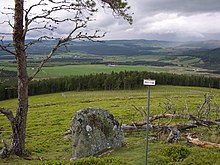Battle of Cromdale
| Battle of Cromdale | |||||||
|---|---|---|---|---|---|---|---|
| Part of the Jacobite rising of 1689 | |||||||
 The Piper's Stone. During the battle a piper, though badly wounded, managed to drag himself atop this boulder and continue to play song after song spurring on his men until he finally fell and died | |||||||
| |||||||
| Belligerents | |||||||
Jacobite Royalists (Highlanders & Irish) | Government (Highlanders & Lowlanders) | ||||||
| Commanders and leaders | |||||||
Major-General Buchan | Sir Thomas Livingstone | ||||||
| Strength | |||||||
1200 reduced to 800 before battle | |||||||
| Casualties and losses | |||||||
400 killed | fewer than 100 killed | ||||||
Registered battlefield | |||||||
| Designated | 30 November 2011 | ||||||
| Reference no. | BTL20 | ||||||
 | |||||||
The Battle of Cromdale took place at the Haughs of Cromdale near Cromdale in Inverness-shire on April 30 and May 1, 1690. The battlefield has been included in the Inventory of Historic Battlefields in Scotland and protected by Historic Scotland under the Scottish Historical Environment Policy of 2009.[2]
Contents
1 Background
2 Battle
3 Aftermath
4 Notes and references
5 External links
Background
After their defeat at the Battle of Dunkeld in 1689, the Highland clans had returned to their homes in low spirits. Sir Ewen Cameron assumed control over the army's remnant. Sir Ewen and the other Jacobite chiefs complained to King James over the precarious state of his support in Scotland and the necessity of sending them aid. James was occupied with preparations for resisting a threatened invasion of Ireland. To aid his supporters in Scotland, James sent clothing, arms, ammunition and provisions. He also directed a few officers from Ireland to Lochaber, among whom was Major-General Thomas Buchan, whom James made commander-in-chief of the Jacobite forces in Scotland.[3]
On Buchan’s arrival, a meeting of the chiefs and principal officers was held at Keppoch to formulate a plan of action. While some of the clans proposed to submit to the government, this proposition was resisted by Sir Ewen. The meeting unanimously resolved to continue the war, but not until the labours of the spring season were complete in the Highlands. The general muster of the clans was postponed. In the mean time a detachment of 1,200 infantrymen was to be placed at Buchan's disposal to weaken the enemy’s quarters along the borders of the Lowlands.
General Buchan advanced his men through Badenoch, intending to march down Speyside into the Duke of Gordon's country, where he expected to muster additional forces. Due to desertion, Buchan’s force had dwindled to 800 men. Ignoring counsel from his Scottish officers not to advance past Culnakill, Buchan marched down the Spey as far as Cromdale where he encamped on the last day of April.
Battle
He was met near Grantown-on-Spey at Cromdale by a larger government force under Sir Thomas Livingston, commander of the garrison of Inverness. As Livingston approached with his men, on the opposite bank of the Spey, the Jacobite forces started to retreat. Livingston's cavalry crossed the river and intercepted the Jacobites who made a brief stand at the foot of the hill of Cromdale. However, a thick fog came down the side of the mountain and enveloped the outnumbered Jacobites, compelling Livingston to discontinue the pursuit. According to reports, the Highlanders had 400 men killed and taken prisoner. Livingston's losses were reported as between none and 100 killed.
A group of around 100 men, who had separated from the main Jacobite force, crossed the Spey the following day. After being pursued by some of Livingston’s men, they were overtaken and dispersed on the moor of Granish near Aviemore, where some of them were killed. They attempted to seize the castle of Lochinclan, but their attack was repelled by the proprietor and his tenants.
Aftermath
The defeat at Cromdale effectively ended the rebellion in Scotland. Nevertheless, Jacobite propagandists declared the action a victory for the Jacobite forces, and composed a popular song, The Haughs of Cromdale, to promote that viewpoint. It is listed in James Hogg's Jacobite Reliques as song number 2. The last verse reads:
The loyal Stuarts, with Montrose,
So boldly set upon their foes,
And brought them down with Highland blows
Upon the Haughs of Cromdale.
Of twenty-thousand Cromwell's men,
a thousand fled to Aberdeen,
The rest of them lie on the plain,
They're on the Haughs of Cromdale.
Of twenty-thousand of Cromwell's men,
a-thousand fled to Aberdeen,
The rest of them lie on the plain,
They're on the Haughs of Cromdale.
Strangely enough, the hero of the song, James Graham, 1st Marquess of Montrose, died forty years before the battle occurred. The tune has remained popular and is still played by pipe bands.
Notes and references
^ Site Record for Cromdale, Royal Commission on the Ancient and Historical Monuments of Scotland.mw-parser-output cite.citationfont-style:inherit.mw-parser-output .citation qquotes:"""""""'""'".mw-parser-output .citation .cs1-lock-free abackground:url("//upload.wikimedia.org/wikipedia/commons/thumb/6/65/Lock-green.svg/9px-Lock-green.svg.png")no-repeat;background-position:right .1em center.mw-parser-output .citation .cs1-lock-limited a,.mw-parser-output .citation .cs1-lock-registration abackground:url("//upload.wikimedia.org/wikipedia/commons/thumb/d/d6/Lock-gray-alt-2.svg/9px-Lock-gray-alt-2.svg.png")no-repeat;background-position:right .1em center.mw-parser-output .citation .cs1-lock-subscription abackground:url("//upload.wikimedia.org/wikipedia/commons/thumb/a/aa/Lock-red-alt-2.svg/9px-Lock-red-alt-2.svg.png")no-repeat;background-position:right .1em center.mw-parser-output .cs1-subscription,.mw-parser-output .cs1-registrationcolor:#555.mw-parser-output .cs1-subscription span,.mw-parser-output .cs1-registration spanborder-bottom:1px dotted;cursor:help.mw-parser-output .cs1-ws-icon abackground:url("//upload.wikimedia.org/wikipedia/commons/thumb/4/4c/Wikisource-logo.svg/12px-Wikisource-logo.svg.png")no-repeat;background-position:right .1em center.mw-parser-output code.cs1-codecolor:inherit;background:inherit;border:inherit;padding:inherit.mw-parser-output .cs1-hidden-errordisplay:none;font-size:100%.mw-parser-output .cs1-visible-errorfont-size:100%.mw-parser-output .cs1-maintdisplay:none;color:#33aa33;margin-left:0.3em.mw-parser-output .cs1-subscription,.mw-parser-output .cs1-registration,.mw-parser-output .cs1-formatfont-size:95%.mw-parser-output .cs1-kern-left,.mw-parser-output .cs1-kern-wl-leftpadding-left:0.2em.mw-parser-output .cs1-kern-right,.mw-parser-output .cs1-kern-wl-rightpadding-right:0.2em
^ "Inventory battlefields". Historic Scotland. Retrieved 2012-04-12.
^ An officer in the Army. "Memoirs of the Lord Viscount Dundee." London: Robert Chapman 1818. p. 23
External links
- The lyrics to The Haughs o' Cromdale
Historic Environment Scotland. "Battle of Cromdale (BTL20)".
